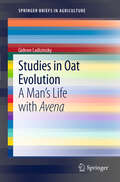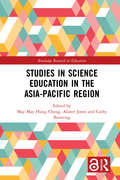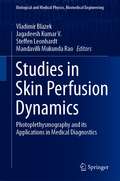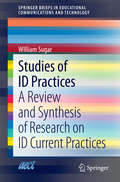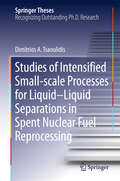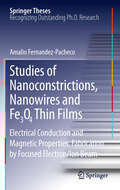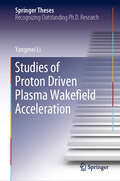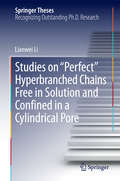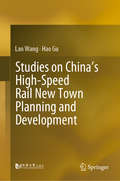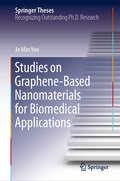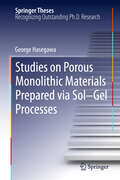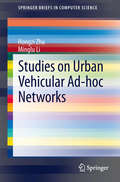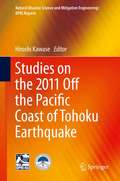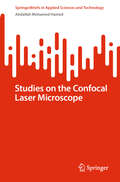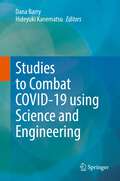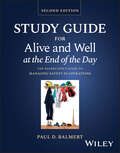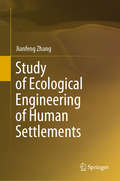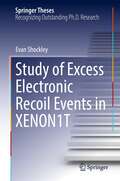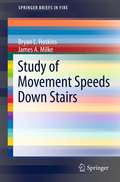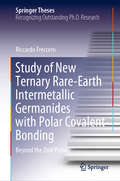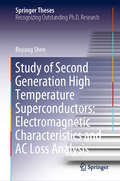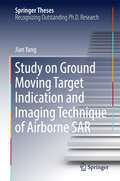- Table View
- List View
Studies in Environment and History: Empire of Timber
by Erik LoomisThe battles to protect ancient forests and spotted owls in the Northwest splashed across the evening news in the 1980s and early 1990s. Empire of Timber re-examines this history to demonstrate that workers used their unions to fight for a healthy workplace environment and sustainable logging practices that would allow themselves and future generations the chance to both work and play in the forests. Examining labor organizations from the Industrial Workers of the World in the 1910s to unions in the 1980s, Empire of Timber shows that conventional narratives of workers opposing environmental protection are far too simplistic and often ignore the long histories of natural resource industry workers attempting to protect their health and their futures from the impact of industrial logging. Today, when workers fear that environmental restrictions threaten their jobs, learning the history of alliances between unions and environmentalists can build those conversations in the present.
Studies in Environment and History: Feral Animals in the American South
by Abraham GibsonThe relationship between humans and domestic animals has changed in dramatic ways over the ages, and those transitions have had profound consequences for all parties involved. As societies evolve, the selective pressures that shape domestic populations also change. Some animals retain close relationships with humans, but many do not. Those who establish residency in the wild, free from direct human control, are technically neither domestic nor wild: they are feral. If we really want to understand humanity's complex relationship with domestic animals, then we cannot simply ignore the ones who went feral. This is especially true in the American South, where social and cultural norms have facilitated and sustained large populations of feral animals for hundreds of years. Feral Animals in the American South retells southern history from this new perspective of feral animals.
Studies in Environment and History: Waste into Weapons
by Peter ThorsheimDuring the Second World War, the United Kingdom faced severe shortages of essential raw materials. To keep its armaments factories running, the British government enlisted millions of people in efforts to recycle a wide range of materials for use in munitions production. Recycling not only supplied British munitions factories with much-needed raw materials - it also played a key role in the efforts of the British government to maintain the morale of its citizens, to secure billions of dollars in Lend-Lease aid from the United States, and to uncover foreign intelligence. However, Britain's wartime recycling campaign came at a cost: it consumed items that would never have been destroyed under normal circumstances, including significant parts of the nation's cultural heritage. Based on extensive archival research, Peter Thorsheim examines the relationship between armaments production, civil liberties, cultural preservation, and diplomacy, making Waste into Weapons the first in-depth history of twentieth-century recycling in Britain.
Studies in Oat Evolution
by Gideon LadizinskyThe book is based on the author's life time experience in exploring and researching the genus Avena. It describes some great events in oat research and minor stories along the way. It will be of interest and value to all those working with oats and to students and scientists of crop evolution, including those dealing with collecting and conserving wild genetic resources. A first part deals with the morphology and taxonomy of the genus and a classification based on the biological species concept is presented. A further part is devoted to the author's research accomplishments in this genus. It describes morphological characters distinguishing between diploids and tetraploids of series Eubarbatae, the genetic relationships between them, and the mode of origin of the tetraploid form. The section Denticulatae, to which the common oat belongs, is extensively treated. Further, oat domestication and the newly domesticated protein rich A. magna are described. A third part deals with wild genetic resources of oat.
Studies in Science Education in the Asia-Pacific Region (Routledge Research in Education)
by Alister Jones Cathy Buntting May ChengConsistent with international trends, there is an active pursuit of more engaging science education in the Asia-Pacific region. The aim of this book is to bring together some examples of research being undertaken at a range of levels, from studies of curriculum and assessment tools, to classroom case studies, and investigations into models of teacher professional learning and development. While neither a comprehensive nor definitive representation of the work that is being carried out in the region, the contributions—from China, Hong Kong, Taiwan, Korea, Japan, Singapore, Australia, and New Zealand—give a taste of some of the issues being explored, and the hopes that researchers have of positively influencing the types of science education experienced by school students. The purpose of this book is therefore to share contextual information related to science education in the Asia-Pacific region, as well as offering insights for conducting studies in this region and outlining possible questions for further investigation. In addition, we anticipate that the specific resources and strategies introduced in this book will provide a useful reference for curriculum developers and science educators when they design school science curricula and science both pre-service and in-service teacher education programmes. The first section of the book examines features of science learners and learning, and includes studies investigating the processes associated with science conceptual learning, scientific inquiry, model construction, and students’ attitudes towards science. The second section focuses on teachers and teaching. It discusses some more innovative teaching approaches adopted in the region, including the use of group work, inquiry-based instruction, developing scientific literacy, and the use of questions and analogies. The third section reports on initiatives related to assessments and curriculum reform, including initiatives associated with school-based assessment, formative assessment strategies, and teacher support accompanying curriculum reform.
Studies in Skin Perfusion Dynamics: Photoplethysmography and its Applications in Medical Diagnostics (Biological and Medical Physics, Biomedical Engineering)
by Steffen Leonhardt Vladimir Blazek Jagadeesh Kumar V. Mandavilli Mukunda RaoThis book talks about photoplethysmography (PPG) techniques based on computer-aided data processing. In particular, it presents the results of a co-operative Indo-German project on the topic between Indian Institute of Technology at Chennai and RWTH Aachen University. Measuring system design, experimental details and some preliminary results obtained so far within the framework of this project are presented here. From the investigations carried out so far using the PPG sensors in conjunction with breathing sensors, it has been possible to monitor the 0.125 to 0.15 Hz rhythms in the arterial volumetric changes and to study the influence of breathing on them. These rhythms, which according to medical experts have relevance to psychosomatic conditions e.g. stress or relaxation, can also be addressed to by ancient Indian practices like yoga and meditation. This book presents the results of studying the effects of Indian relaxation techniques like pranayama, meditation, etc. in comparison to western relaxation techniques like autogenic training. So far it has been established that the Indian techniques of relaxation like yoga and meditation are very effective in generating low frequency rhythms in the skin perfusion as monitored by optical sensors. According to medical experts, these low frequency rhythms have a very important bearing on the human physiology and have potential therapeutic implications. This book is meant to provide an overview of the current state-of-knowledge and encourage the next generation of scientists/engineers to carry this work forward, especially on the novel PPG application fields that are of growing importance like pain and stress assessment, detection of peripheral venous saturation and local arterio-venous oxygen consumption as well as contactless space resolved skin perfusion studies with modern camera based PPG technology.
Studies of ID Practices
by William SugarThis book provides a comprehensive analysis of cutting edge research studies on contemporary instructional design practices. Written for instructional designers, instructional technologists and researchers in the field, it provides state of the art, practically focused information and guidelines for designing curriculum and professional ID practice. The author compares professional instructional design practices with the competencies established by the International Board for Training, Performance, and Instruction to evaluate and investigate their effectiveness and increase the efficiency of the entire instructional design process.
Studies of Intensified Small-scale Processes for Liquid-Liquid Separations in Spent Nuclear Fuel Reprocessing
by Dimitrios A. TsaoulidisThe present work focuses on the development of intensified small-scale extraction units for spent nuclear fuel reprocessing using advanced process engineering with combined experimental and modelling methodologies. It discusses a number of novel elements, such as the intensification of spent fuel reprocessing and the use of ionic liquids as green alternatives to organic solvents. The use of ionic liquids in two-phase liquid-liquid separation is new to the Multiphase Flow community, and has proved to be challenging, especially in small channels, because of the surface and interfacial properties involved, which are very different to those of common organic solvents. Numerical studies have been also performed to couple the hydrodynamics at small scale with the mass transfer. The numerical results, taken together with scale-up studies, are used to evaluate the applicability of the small-scale units in reprocessing large volumes of nuclear waste.
Studies of Nanoconstrictions, Nanowires and Fe3O4 Thin Films
by Amalio Fernandez-PachecoThis work constitutes a detailed study of electrical and magnetic properties in nanometric materials with a range of scales: atomic-sized nanoconstrictions, micro- and nanowires and thin films. Firstly, a novel method of fabricating atomic-sized constrictions in metals is presented; it relies on measuring the conduction of the device while a focused-ion-beam etching process is in progress.
Studies of Proton Driven Plasma Wakefield Acceleration (Springer Theses)
by Yangmei LiThis thesis focuses on a cutting-edge area of research, which is aligned with CERN's mainstream research, the "AWAKE" project, dedicated to proving the capability of accelerating particles to the energy frontier by the high energy proton beam. The author participated in this project and has advanced the plasma wakefield theory and modelling significantly, especially concerning future plasma acceleration based collider design. The thesis addresses electron beam acceleration to high energy whilst preserving its high quality driven by a single short proton bunch in hollow plasma. It also demonstrates stable deceleration of multiple proton bunches in a nonlinear regime with strong resonant wakefield excitation in hollow plasma, and generation of high energy and high quality electron or positron bunches. Further work includes the assessment of transverse instabilities induced by misaligned beams in hollow plasma and enhancement of the wakefield amplitude driven by a self-modulated long proton bunch with a tapered plasma. This work has major potential to impact the next generation of linear colliders and also in the long-term may help develop compact accelerators for use in industrial and medical facilities.
Studies on "Perfect" Hyperbranched Chains Free in Solution and Confined in a Cylindrical Pore
by Lianwei LiLianwei Li's Ph. D. thesis solves a long-standing problem in polymer physics: how does a hyperbranched chain pass through a cylindrical pore smaller than its size under an elongational flow field? The question was asked by the Nobel Laureate, the late Professor de Gennes in the 70s but has never been seriously addressed through real experiments. This thesis outlines how Lianwei Li developed a novel polymerization strategy using a seesaw-type macromonomer to prepare a set of "defect-free" hyperbranched chagins with different overall molar masses and controllable uniform subchain lengths. The author then unearthed how the critical (minimum) flow rate at which a hyperbranched chain can pass through the pore, is dependent on the overall molar mass and the subchain length. The experimental results give a unified description of polymer chains with different topologies passing through a small cylindrical pore, which enables us to separate chains by their topologies instead of their sizes in ultrafiltration. In addition, this research also reveals how the chain structure of amphiphilic hyperbranched block and graft copolymers affect their solution properties, including the establishments of several classic scaling laws that relate the chain size and the intrinsic viscosity to the overall molar mass and the subchain length, respectively. This work has led to numerous publications in high-impact peer-reviewed journals.
Studies on China’s High-Speed Rail New Town Planning and Development
by Lan Wang Hao GuThis book focuses on high-speed rail (HSR) and new town planning and development related to HSR, approaching the issue from three different perspectives: economic cooperation at a regional level; HSR-based economic growth point at a city level; and mixed land use and building environment in the periphery area of HSR stations. On the basis of simulations and case studies, it proposes practical planning principles and suggestions for area development, providing planners with a theoretical framework to incorporate the transportation system into new town planning. It also serves as a valuable reference source for the authorities, enabling them to make evidence-based and rational decisions.
Studies on Graphene-Based Nanomaterials for Biomedical Applications (Springer Theses)
by Je Min YooThis thesis presents various applications of graphene-based nanomaterials, especially in biomedicine. Graphene and its derivatives have gained enormous attention from scientists in all fields of study due to many unprecedented properties. The initial scientific attention was focused on the development of transparent flexible electrodes by exploiting two-dimensional graphene film’s extraordinary electrical and physical properties. Recently, given an increasing evidence of dispersed graphene-based nanomaterials’ biocompatibility, researchers have endeavored to employ these materials in other studies relevant to biomedical technologies. In this respect, the thesis provides a comprehensive review on the synthesis, toxicity, and a few of the key biomedical applications in the first chapter. The following chapter discusses the use of a graphene film as a novel catalyst to oxidatively destroy phenols, which are known to be potentially mutagenic and carcinogenic. Finally, and most importantly, the last chapter introduces the therapeutic role of graphene quantum dots, the smallest graphene-based nanomaterials, for Parkinson’s disease. The results are promising for the use of graphene quantum dots as the basis of future clinical drug candidates for neurodegenerative disorders.
Studies on Porous Monolithic Materials Prepared via Sol–Gel Processes
by George HasegawaThis thesis focuses on porous monolithic materials that are not in the forms of particles, fibers, or films. In particular, the synthetic strategy of porous monolithic materials via the sol-gel method accompanied by phase separation, which is characterized as the non-templating method for tailoring well-defined macropores, is described from the basics to actual synthesis. Porous materials are attracting more and more attention in various fields such as electronics, energy storage, catalysis, sensing, adsorbents, biomedical science, and separation science. To date, many efforts have been made to synthesize porous materials in various chemical compositions--organics, inorganics including metals, glasses and ceramics, and organic-inorganic hybrids. Also demonstrated in this thesis are the potential applications of synthesized porous monolithic materials to separation media as well as to electrodes for electric double-layer capacitors (EDLCs) and Li-ion batteries (LIBs). This work is ideal for graduate students in materials science and is also useful to engineers or scientists seeking basic knowledge of porous monolithic materials.
Studies on Urban Vehicular Ad-hoc Networks
by Minglu Li Hongzi ZhuWith the advancement of wireless technology, vehicular ad hoc networks (VANETs) are emerging as a promising approach to realizing "smart cities" and addressing many important transportation problems such as road safety, efficiency, and convenience. This brief provides an introduction to the large trace data set collected from thousands of taxis and buses in Shanghai, the largest metropolis in China. It also presents the challenges, design issues, performance modeling and evaluation of a wide spectrum of VANET research topics, ranging from realistic vehicular mobility models and opportunistic routing, to real-time vehicle tracking and urban sensing applications. In addition to the latest research and techniques, the reader will also learn the trace-driven methodologies and tools of performance modeling and analysis, network protocol design and optimization, and network simulation, thus keeping pace with the fast moving VANET research and development.
Studies on the 2011 Off the Pacific Coast of Tohoku Earthquake (Natural Disaster Science and Mitigation Engineering: DPRI reports)
by Hiroshi KawaseThe Tohoku earthquake on March 11, 2011, officially designated the “Off the Pacific Coast of Tohoku, Japan Earthquake” by the Japan Meteorological Agency caused an unprecedentedly severe disaster in the northeastern part (Tohoku) of the Japanese island of Honshu. This first volume of the series Natural Disaster Science and Mitigation Engineering: DPRI Reports covers various aspects of investigations of scientific findings as well as issues related to the disaster and the subsequent evacuation necessitated by the earthquake. The series presents recent advances in natural disaster sciences and mitigation technologies developed in Japan, which will be valuable for the mitigation of disasters of a similar kind resulting from future events around the world.
Studies on the Confocal Laser Microscope (SpringerBriefs in Applied Sciences and Technology)
by Abdallah Mohamed HamedThis book provides a thorough exploration of various modulated apertures and their impact on improving microscope resolution, with a focus on confocal scanning laser microscopy (CSLM). Over the course of eleven chapters, it looks at both the theoretical aspects and practical applications of different aperture shapes. Chapters 1 and 2 review apertures with linear, quadratic, and concentric black-and-white (B/W) zones, along with linear-quadratic and polynomial designs. Additionally, apertures with Hamming, Cauchy, rectangular, and hexagonal shapes are analyzed for their potential to enhance imaging performance. Chapter 3 presents the computation of coherent transfer functions (CTFs) for selected modulated apertures, offering insights into their influence on imaging quality. Chapter 4 focuses on confocal microscopes, exploring how these apertures affect the imaging of microscopic objects. A theoretical study of coherent non-scanned laser microscopes (CNSM) is covered in Chapter 5. Chapter 6 addresses the computation of lateral and axial point spread functions (PSFs) in confocal imaging systems that use binary amplitude masks, while Chapter 7 investigates the effects of misalignment errors combined with wavefront aberrations in systems using linear and quadratic apertures. In Chapter 8, diffraction intensity is calculated for a confocal microscope with a laterally displaced truncated Gaussian aperture, extending the principles of Marechal microscopy to confocal scanning microscopy. Chapters 9 and 10 examine spatial coherence in confocal optical systems, particularly in the context of quadratic and concentric B/W apertures. The book concludes in Chapter 11 with an application of cardiac apertures in CSLM, demonstrating their use in processing cardiac images. This work serves as a valuable reference for researchers and professionals interested in advancing microscope resolution through innovative aperture design and analysis.
Studies to Combat COVID-19 using Science and Engineering
by Hideyuki Kanematsu Dana BarryThis unique book provides excellent examples of ongoing, leading-edge research related to viruses, especially COVID-19. It is written from the viewpoint of various scientific fields including materials science. It introduces and describes viruses (submicroscopic infectious agents that replicate inside the living cells of an organism), various infections caused by viruses (human to human, human to other organisms to humans, humans to materials to humans, etc.), not only from the viewpoint of medical research but also from other scientific disciplines. A major focus of the book is the COVID-19 virus. Highlighted topics include the evolution of COVID-19, transmission of virus particles through the air, virus spread through various materials, detection of the virus by testing wastewater, the development and testing of vaccines and therapeutic drugs, and the preparation for future viruses and pandemics. This includes reform in funeral services to properly and safely accommodate very large numbers of bodies in a pandemic, like those seen in New York City when it was the epicenter for the virus in the United States. This book serves as an excellent and very informative guide (practical book) for engineers and researchers of various backgrounds and as a great academic textbook.
Study Guide for Alive and Well at the End of the Day: The Supervisor's Guide to Managing Safety in Operations, Second Edition
by Paul D. BalmertSTUDY GUIDE FOR Alive and Well at the End of the Day Teaching aid underscoring the principles of effective safety leadership The Second Edition of Alive and Well at the End of the Day provides industrial leaders in operations with practical solutions to the tough safety leadership challenges they must manage. The book describes in detail the nature of those challenges (what makes them that tough) and offers proven best practices to successfully deal with them. The Study Guide is designed as a teaching aid for the Alive and Well book. Created by the highly experienced training specialists of Balmert Consulting, the Study Guide uses training best practices to help affix the concepts of Alive and Well in the minds of professional students. The use of strategically-crafted questions—both at the beginning and end of each review session—allows the student to work with the material conceptually, becoming more familiar and facile with it. Alive and Well is designed to teach front-line supervisors of workers in a wide range of industries how to help and guide their employees to understand the risks involved in the various aspects of their work, and how to cope with those risks and to plan and execute their jobs in ways that can help eliminate injuries. The topic of the Study Guide is the content of the book; its purpose is to help both supervisors and those reporting to them to more sharply focus on the principles in the book; to more fully understand and remember them; and to be able to apply them in everyday work situations.
Study of Ecological Engineering of Human Settlements
by Jianfeng ZhangThis book analyzes the theory of ecological engineering of human settlements and provides case studies on the improvement of degraded lands and vegetation restoration, especially focusing on saline-alkali land, abandoned land, water source areas, and the impact of green belts on noise and air quality on the highways. In addition, it discusses the issue of biodiversity conservation strategies in rural landscape construction and demonstrates experiment measurement and field survey methods. The results obtained are supplemented by numerical calculations, presented in the form of tables and figures.As the first monograph on this subject, the book provides a wealth of ideas and resources for researchers, professionals and practitioners in the field of human settlements.
Study of Excess Electronic Recoil Events in XENON1T (Springer Theses)
by Evan ShockleyThis thesis summarizes the original analysis work performed by the author on data from XENON1T, a search for dark matter with a ton-size noble liquid detector operated at Gran Sasso Underground Laboratory in Italy. The nature of dark matter is one of the most open and pressing questions of modern physics, and the unique data acquired with this detector allows the exploration and investigation of several potential scenarios. The analysis of Dr. Shockley searches for a class of elusive elementary particles that interact with the electrons of ordinary atoms, instead of the nucleus. Results of the analysis present, with high confidence, an excess with respect to the expected background. Beyond more mundane explanations, this additional rate of electron-mediated interactions might be a first hint of physics beyond the standard model. This accessible thesis provides details on the detector, the data, and the theory, delivering to the reader an in-depth and coherent picture of the search for physics beyond the standard model.
Study of Movement Speeds Down Stairs
by James A. Milke Bryan L. HoskinsThe Study of Movement Speeds Down Stairs closely examines forty-three unique case studies on movement patterns down stairwells. These studies include observations made during evacuation drills, others made during normal usage, interviews with people after fire evacuations, recommendations made from compiled studies, and detailed results from laboratory studies. The methodology used in each study for calculating density and movement speed, when known, are also presented, and this book identifies an additional seventeen variables linked to altering movement speeds. The Study of Movement Speeds Down Stairs is intended for researchers as a reference guide for evaluating pedestrian evacuation dynamics down stairwells. Practitioners working in a related field may also find this book invaluable.
Study of New Ternary Rare-Earth Intermetallic Germanides with Polar Covalent Bonding: Beyond the Zintl Picture (Springer Theses)
by Riccardo FrecceroThe thesis focuses on the syntheses, structural characterizations and chemical bonding analyses for several ternary R–M–Ge (R = rare earth metal; M = another metal) intermetallics. The challenges in understanding the main interactions governing the chemistry of these compounds, which lead to our inability to predict their formation, structure and properties, are what provided the motivation for this study. In particular, the R2MGe6 (M = Li, Mg, Al, Cu, Zn, Pd, Ag), R4MGe10-x (M = Li, Mg), R2Pd3Ge5, Lu5Pd4Ge8, Lu3Pd4Ge4 and Yb2PdGe3 phases were synthesized and structurally characterized. Much effort was put into the stabilization of metastable phases, employing the innovative metal flux method, and into the accurate structure solution of twinned crystals. Cutting-edge position-space chemical bonding techniques were combined with new methodologies conceived to correctly describe the Ge–M, Ge–La and also La–M polar-covalent interactions for the La2MGe6 (M = Li, Mg, Al, Cu, Zn, Pd, Ag) series. The present results constitute a step forward in our comprehension of ternary germanide chemistry as well as providing a good playground for further investigations.
Study of Second Generation High Temperature Superconductors: Electromagnetic Characteristics and AC Loss Analysis (Springer Theses)
by Boyang ShenThis thesis introduces a systematic study on Second Generation (2G) High Temperature Superconductors (HTS), covering a novel design of an advanced medical imaging device using HTS, and an in-depth investigation on the losses of HTS.The text covers the design and simulation of a superconducting Lorentz Force Electrical Impedance Tomography. This is potentially a significant medical device that is more efficient and compact than an MRI, and is capable of detecting early cancer, as well as other pathologies such stroke and internal haemorrhages. It also presents the information regarding the fundamental physics of superconductivity, concentrating on the AC losses in superconducting coils and tapes.Overall, the thesis signifies an important contribution to the investigation of High Temperature Superconductors. This thesis will be beneficial to the development of advanced superconducting applications in healthcare as well as more broadly in electrical and energy systems.
Study on Ground Moving Target Indication and Imaging Technique of Airborne SAR
by Jian YangBased on a detailed analysis of the signal model of the moving target, this thesis focuses on the theories and applications of ground moving target indicator (GMTI) and ground moving target imaging (GMTIm) algorithms in synthetic aperture radar/ ground moving target indicator (SAR/GMTI mode), wide-area surveillance ground moving target indication (WAS-GMTI) mode and frequency modulated continuous wave synthetic aperture radar (FMCW SAR) systems. The proposed algorithms can not only indicate and image fast-moving targets, but are also effective in the context of slow-moving target processing. The system design scheme combines the mechanical scanning mode and the airborne SAR system, while the azimuth moving target indication algorithm employs the additional range walk migration induced by FMCW SAR systems. In addition, the non-ideal errors that deteriorate the performance of GMTIm algorithms in real SAR data processing are discussed, and suitable compensation methods are provided.

